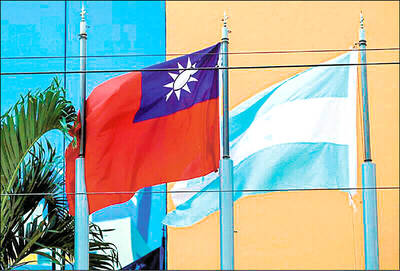China is developing a new class of helicopters that could pose a direct threat to Taiwan, a leading US military analyst said.
In the case of an attack, Taiwan would have much less time to mobilize its counter-invasion forces, said Richard Fisher, a senior fellow at the International Assessment and Strategy Center (IASC).
He says that at the China Helicopter Exposition held in Tianjin, China, earlier this month, Aviation Industries of China (AVIC) revealed two advanced helicopter concepts in model form — a quad-tilt rotor and a high-speed design.
While it could be some time before they are operational, their development is advanced enough to cause concern, he said.
“They are the result of an accelerated Chinese investment in helicopter technology that aims to raise indigenous design and production capabilities to world-class levels,” Fisher said.
In “China’s Advanced Helicopter Concepts” — published this week by the IASC — Fisher says that one of China’s new helicopters, known as the Blue Whale, will have a quad-tilt rotor design and a 20-tonne payload.
It is expected to have a range of 3,100km and a combat radius of 815km.
The Blue Whale will feature significant use of composite materials, “intelligent” avionics and flight controls and cabin noise levels similar to that of airliners.
Also unveiled in Tianjin was the high-speed Jueying-8 “Absolute Shadow,” which was described as an unmanned high-speed helicopter technology test platform.
It is expected to have a top speed of 450kph and may make its first flight in 2015.
“The emergence of a Chinese quad tilt rotor program points to potential Chinese strategic intentions,” Fisher wrote.
“It now appears, provided it can overcome technical challenges and sustain funding, that China may be the first to reap the strategic benefits of new concepts for heavy and fast vertical lift,” Fisher said.
He speculates that with a Blue Whale that could lift 20 tonnes at speeds of more than 480kph, the People’s Liberation Army (PLA) could be the first to deploy in a regional conflict.
It might, for example, occupy the Diaoyutai Islands (釣魚台列嶼) or capture airfields in the Sakashima Islands, which would allow larger transport aircraft to bring in heavy air defense and anti-ship ballistic missiles to thwart a Japanese-US attempt to retake the islands.
“From the Sakashimas, the Blue Whale could also spearhead a multi-axis attack to capture airfields on Taiwan with current light-weight Chinese Airborne mechanized forces, to ease the way for follow-on invasion forces,” Fisher said.
In an interview with the Taipei Times, Fisher said the emergence of the Blue Whale means the PLA could attempt to capture key targets in Taiwan like the Presidential Office or the National Security Bureau without first capturing airfields and ports.
“The ability of a platform like the Blue Whale to rapidly project both fighting vehicles and significant numbers of heavily armed infantry and special forces also means that Taiwan will have much less time to mobilize its counter-invasion forces,” he said.
Fisher said that if the PLA meets with success in developing tilt rotor technology, then consideration should be given by Taiwan to training police and militia in the use of shoulder-fired anti-armor and anti-aircraft missiles.
Taiwan should consider buying more of these weapons to ensure they are “immediately available” to counter PLA airborne invasion forces, he said.

Chinese Nationalist Party (KMT) Chairman Eric Chu (朱立倫), spokeswoman Yang Chih-yu (楊智伃) and Legislator Hsieh Lung-chieh (謝龍介) would be summoned by police for questioning for leading an illegal assembly on Thursday evening last week, Minister of the Interior Liu Shyh-fang (劉世芳) said today. The three KMT officials led an assembly outside the Taipei City Prosecutors’ Office, a restricted area where public assembly is not allowed, protesting the questioning of several KMT staff and searches of KMT headquarters and offices in a recall petition forgery case. Chu, Yang and Hsieh are all suspected of contravening the Assembly and Parade Act (集會遊行法) by holding

PRAISE: Japanese visitor Takashi Kubota said the Taiwanese temple architecture images showcased in the AI Art Gallery were the most impressive displays he saw Taiwan does not have an official pavilion at the World Expo in Osaka, Japan, because of its diplomatic predicament, but the government-backed Tech World pavilion is drawing interest with its unique recreations of works by Taiwanese artists. The pavilion features an artificial intelligence (AI)-based art gallery showcasing works of famous Taiwanese artists from the Japanese colonial period using innovative technologies. Among its main simulated displays are Eastern gouache paintings by Chen Chin (陳進), Lin Yu-shan (林玉山) and Kuo Hsueh-hu (郭雪湖), who were the three young Taiwanese painters selected for the East Asian Painting exhibition in 1927. Gouache is a water-based

Taiwan would welcome the return of Honduras as a diplomatic ally if its next president decides to make such a move, Minister of Foreign Affairs Lin Chia-lung (林佳龍) said yesterday. “Of course, we would welcome Honduras if they want to restore diplomatic ties with Taiwan after their elections,” Lin said at a meeting of the legislature’s Foreign Affairs and National Defense Committee, when asked to comment on statements made by two of the three Honduran presidential candidates during the presidential campaign in the Central American country. Taiwan is paying close attention to the region as a whole in the wake of a

OFF-TARGET: More than 30,000 participants were expected to take part in the Games next month, but only 6,550 foreign and 19,400 Taiwanese athletes have registered Taipei city councilors yesterday blasted the organizers of next month’s World Masters Games over sudden timetable and venue changes, which they said have caused thousands of participants to back out of the international sporting event, among other organizational issues. They also cited visa delays and political interference by China as reasons many foreign athletes are requesting refunds for the event, to be held from May 17 to 30. Jointly organized by the Taipei and New Taipei City governments, the games have been rocked by numerous controversies since preparations began in 2020. Taipei City Councilor Lin Yen-feng (林延鳳) said yesterday that new measures by